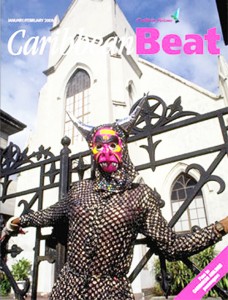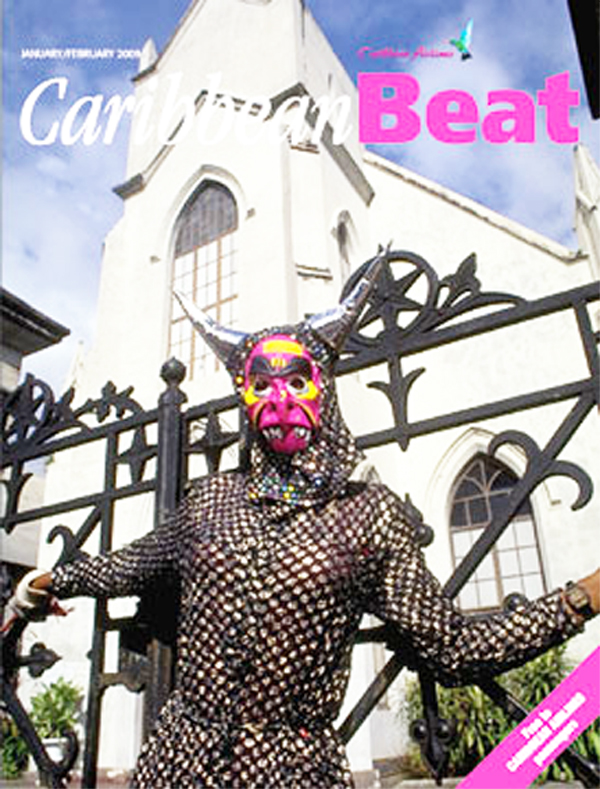Carnival: undergoing change
The January/February edition is usually the carnival issue of the magazine Caribbean Beat produced by MEP for Caribbean Airlines and edited by Judy Raymond. On the surface this issue for 2009 is not very strong on carnival, but it has perhaps three articles of great significance because of what they say about carnival mainly through the door that they leave ajar allowing entry into a discourse on what carnival is today and how it has changed.
 It is always easy and tempting to perpetuate a golden age syndrome; to dwell on the past, lament the present and feel that the old days were always better in comparison with the inferiority of the age in which one now exists. There is always the temptation to fall into this type of sentiment, particularly appealing to those given to nostalgia. When this happens it is helpful to remember that cultural traditions are dynamic, not static. A tradition like carnival is driven by the popular culture, which is always influenced by topicality, fashion, and a changing social environment.
It is always easy and tempting to perpetuate a golden age syndrome; to dwell on the past, lament the present and feel that the old days were always better in comparison with the inferiority of the age in which one now exists. There is always the temptation to fall into this type of sentiment, particularly appealing to those given to nostalgia. When this happens it is helpful to remember that cultural traditions are dynamic, not static. A tradition like carnival is driven by the popular culture, which is always influenced by topicality, fashion, and a changing social environment.
Some of this is what Caribbean Beat January/February 2009 allows us to remember. In many ways it signifies the changes that have overcome carnival. It carries an old traditional ‘devil mas’ on the cover. That costume is the type that was so overwhelmingly popular on the streets of Port of Spain a century ago that it led one commentator to declare that it seems that to play the devil “is everyone’s ambition.” However, the pages inside do not overflow with fascinating features and images exhibiting the festival.
Three articles are stimuli to serious reflection upon changes to carnival; a brief note by Laura Dowrich-Phillips on carnival in Dominica, a short feature on songwriter Winsford De Vine, prolific old writer of calypsos, and another short feature on mas-man Brian MacFarlane. These all allow reflection on the face of carnival today, but it is the advertisements in the magazine that are much more revealing. The articles are as brief as the costumes worn by the attractive girls who adorn the ads, and these revealing bikinis and beads represent the barely legal fashion that constitutes the main attractions on the road carnival Monday and Tuesday.
The note on Dominica carnival, which coincides directly with Trinidad’s, touches on this subject:
“Though there has been an increase in modern-style mas − that is, bikinis and beads − in Dominica in recent years, traditional costumes such as the sensay are very popular. Sensay is a costume of West African origin made of frayed rope and other fibrous materials. The material is tied around the body in layers so that it cascades from the head to the feet and a mask is usually worn over the face, with cow horns forming the headpiece.”
“The structure of Dominica’s carnival, though, resembles that of other West Indian carnivals. There’s a soca monarch competition, a calypso show, queen show, steel bands and a parade of costumed bands through the streets of Roseau. A ‘wet fete’ was introduced last year to add more excitement.”
This note contains a few points of particular interest touching on change, the contemporary costumes as against those of the past or those of historical significance, the regular carnival fare with a soca monarch different from the calypso show, and the introduction of the ‘wet fete.’ Some of these have direct links to the other two articles mentioned above, and the comparisons are instructive.
The Dominican carnival reflects the current features of the West Indian bacchanal but makes a point of bringing back older traditional costumes. The feature on Brian MacFarlane by Mark Lindersay highlights an old tradition and one of the real skills of the mas. That skill is the actual work that goes into the manufacture of the thousands of costumes that hit the road on Monday and Tuesday.
It is a highly developed industry that involves several workers for many months before carnival day. It is such, we are told, that some designers take the production to China to exploit cheap labour. But the focus here is on the traditional design and production of mas.
On the one hand there is the tradition of individuals who decide ‘what they will play’ each year, and build their own individual costume at home then go out with it on the road. The other tradition is individuals who decide ‘which band they will play with,’ register, pay the fee, receive a costume and go out with an organised group. The former practice has waned, and while the latter is more the norm, large bands displaying the pretty mas on carnival Tuesday with elaborate designs including king and queen were in the minority in 2009.
Band of the Year winner MacFarlane is a designer in the mode of Peter Minshall. He
won again in 2009 with ‘Africa: Her People, Her Glory, Her Tears,’ the largest band on the road with several sections and thousands of revellers. It was dominant; winning both king and queen of the year in the Dimanche Gras Show and then overwhelming all else on Tuesday to win going away. The victory was obvious and predictable and there were no serious challengers, although perhaps two or three other large bands had pretty mas of quality.
That told a story about what took place in Trinidad in 2009. Large bands like ‘Africa’ and works like Macfarlane’s were fewer in number and lesser in prominence and there was not that continuous flow of colour, splendour and spectacle that many expect to blaze a trail of glory through the city. The glory on show in today’s carnival is the feminine form, since the trend is best exemplified by the popular Trinidadian band called Tribe. Tribe is trendy and sexy with designs best known for their emphasis on scantily clad revellers. This is the trend of brevity that has become much more popular in today’s carnival than the artistic complexity of the Minshall or Macfarlane-type creations, or the old George Bailey tradition of decades ago, immortalised in song by Sparrow.
These are far outnumbered by bands which bother less with sophisticated designs and opt for the bikini and beads mentioned in the little piece on Dominica. There were fewer kings and queens in 2009 in Trinidad. That has already been the trend in Barbados for many years where the costumed bands are not taken as seriously as they are in Trinidad. The high level of seriousness and popular vigilance in Crop-Over is dedicated to the calypso and the soca monarch, called ‘Party Monarch’ in Barbados.
This brings us to the third Caribbean Beat article. De Vine tells Dowrich-Phillips that he has written several calypsos for performers from Sparrow to Machel Montano, including many winning Road Marches. He has therefore spanned many decades and the changes that have taken place from the conventional calypso to the party songs. In the same way that it has happened in the costumed bands, the popular culture has driven trends that have been brought to bear on the calypso and on carnival itself.
Note that today in Trinidad, as it is in Barbados, Guyana’s Mashramani and carnival in the Eastern Caribbean, there are separate calypso and soca competitions. Formerly the calypso king had to sing two songs for the contest and this became a custom in which one of them was a more up-tempo party type suitable for the road march. Invariably one of those actually won the Road March title. Eventually the soca emphasis became so strong, and the change in the popular culture so emphatic, that there was a split. Soca and party developed their own competition and monarchy.
As it is now, it is almost impossible for a regular calypso to win road march, now reserved for a party soca. In Barbados it is its own separate sub-culture. De Vine says “I don’t like the music playing today: the soca too noisy, the music watered down. Time changes and so do men, so it makes no sense for me to criticise them. I admire Machel and them though, ’cause they have gotten the music out there for people to listen to. Calypso went out there and came back home, thanks to Harry Belafonte. I remember in 1973 I went to a club in Manhattan and the juke box was only filled with Sparrow songs.”
Never mind the contradictory remark about Belafonte, he is articulating decades of change from a Sparrow calypso or road march to a Machel Montano, Destra Garcia or Fay-Ann Lyons-Alvarez party soca. Lord Kitchener in the 1970s already knew where the popular culture was located and perhaps outstripped the competition because in this respect he was ahead of his time. Grinner did the same in Barbados in the eighties.

